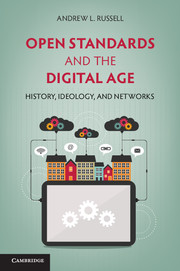Book contents
- Frontmatter
- Dedication
- Contents
- Tables and Figures
- Acknowledgments
- List of acronyms
- 1 Introduction
- 2 Ideological Origins of Open Standards I: Telegraph and Engineering Standards, 1860s–1900s
- 3 Ideological Origins of Open Standards II: American Standards, 1910s–1930s
- 4 Standardization and the Monopoly Bell System, 1880s–1930s
- 5 Critiques of Centralized Control, 1930s–1970s
- 6 International Standards for the Convergence of Computers and Communications, 1960s–1970s
- 7 Open Systems and the Limits of Democratic Design, 1970s–1980s
- 8 The Internet and the Advantages of Autocratic Design, 1970s–1990s
- 9 Conclusion
- Bibliography
- Index
- References
5 - Critiques of Centralized Control, 1930s–1970s
Published online by Cambridge University Press: 05 June 2014
- Frontmatter
- Dedication
- Contents
- Tables and Figures
- Acknowledgments
- List of acronyms
- 1 Introduction
- 2 Ideological Origins of Open Standards I: Telegraph and Engineering Standards, 1860s–1900s
- 3 Ideological Origins of Open Standards II: American Standards, 1910s–1930s
- 4 Standardization and the Monopoly Bell System, 1880s–1930s
- 5 Critiques of Centralized Control, 1930s–1970s
- 6 International Standards for the Convergence of Computers and Communications, 1960s–1970s
- 7 Open Systems and the Limits of Democratic Design, 1970s–1980s
- 8 The Internet and the Advantages of Autocratic Design, 1970s–1990s
- 9 Conclusion
- Bibliography
- Index
- References
Summary
Standardization provided a stamp of approval and a level of acceptance and stability. The characteristics of the language would no longer be subject to the whims of a single organization. There would be an industry-wide voice in the definition of features and the timing of their introduction.
– Martin Greenfield, “History of FORTRAN Standardization,” 1982By the middle decades of the twentieth century, the architects and engineers of communication networks understood that standardization provided a powerful strategy and tool kit for control. In the early twentieth century, AT&T chief engineer Bancroft Gherardi and his colleagues at the top of the Bell System hierarchy nurtured a corporate culture – and an ideology of standardization – that privileged stability and caution over radical technological or organizational change. The question of control, as we have seen, was at the core of tensions between telephone engineers in local Bell operating companies and AT&T executives in New York. Even as Gherardi and his fellow executives struggled mightily to centralize control, they faced a wide range of recalcitrant obstacles, such as resistance from the Bell operating companies and competing firms, adversarial state and federal regulators, and rapid changes in the scientific and technological foundations of their industry.
From the 1930s to the 1970s, critiques of AT&T’s style of centralized control arose from a variety of sources in American society. They are noteworthy as critiques – and not mere criticisms – because they were more elaborate than ordinary gripes about high rates or other aspects of telephone service. They did not only criticize the status quo; these critiques also began to build alternatives to the status quo that would take power out of the hands of Bell System employees and put it into the hands of a more diverse group of engineers, regulators, and users.
- Type
- Chapter
- Information
- Open Standards and the Digital AgeHistory, Ideology, and Networks, pp. 131 - 160Publisher: Cambridge University PressPrint publication year: 2014

